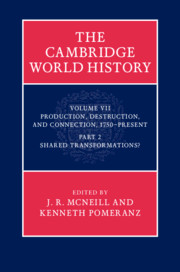Book contents
- The Cambridge World HistoryVolume VII
- The Cambridge World History
- The Cambridge World HistoryProduction, Destruction, and Connection, 1750–Present
- Copyright page
- Contents
- Figures
- Maps
- Tables
- Contributors
- Preface
- Part I Social developments
- Part II Culture and Connections
- Part III Moments
- Part IV Ligaments of Globalization
- 17 Transportation and communication, 1750 to the present
- 18 Rubber
- 19 Drugs in the modern era
- 20 The automobile
- 21 Globalization, Anglo-American style
- Index
- References
18 - Rubber
from Part IV - Ligaments of Globalization
Published online by Cambridge University Press: 05 May 2015
- The Cambridge World HistoryVolume VII
- The Cambridge World History
- The Cambridge World HistoryProduction, Destruction, and Connection, 1750–Present
- Copyright page
- Contents
- Figures
- Maps
- Tables
- Contributors
- Preface
- Part I Social developments
- Part II Culture and Connections
- Part III Moments
- Part IV Ligaments of Globalization
- 17 Transportation and communication, 1750 to the present
- 18 Rubber
- 19 Drugs in the modern era
- 20 The automobile
- 21 Globalization, Anglo-American style
- Index
- References
Summary
Keywords
- Type
- Chapter
- Information
- The Cambridge World History , pp. 423 - 443Publisher: Cambridge University PressPrint publication year: 2015
References
Further reading
- 1
- Cited by



